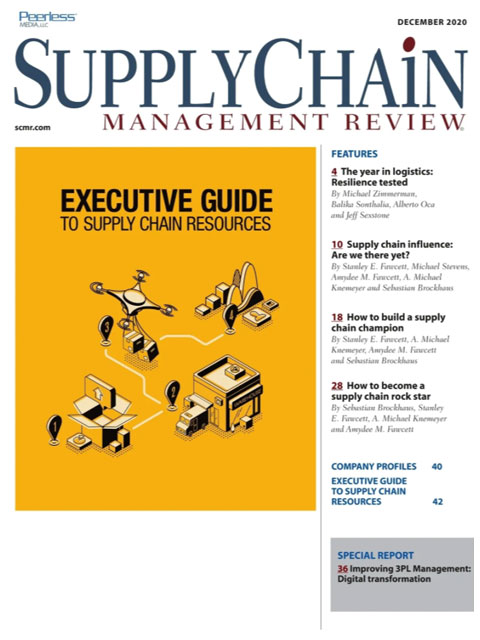Sorry, but your login has failed. Please recheck your login information and resubmit. If your subscription has expired, renew here.
December 2020
Each December, the focus of the issue is our annual Executive Guide to Supply Chain Resources. This is a comprehensive guide to services, products and educational opportunities targeted specifically to supply chain professionals. But, as with years past, we’re also featuring several articles we trust will give you something to think about in the coming year. Browse this issue archive.Need Help? Contact customer service 847-559-7581 More options
2020 has been a year like no other in logistics. A global pandemic, and measures taken to reduce its further spread, decimated supply chains, scrambled logistics capabilities and destroyed huge swaths of demand. Although most observers expect an economic recovery, its size, shape and timing remain in question.
Across sectors, conditions challenged shippers and providers alike. Logistics leaders responded to crises—often with prescience, efficiency and a welcome dollop of charm. But in the big picture, three stories emerged. First was the accelerating growth of e-commerce, with particular challenges posed by the shift to home delivery. Second was higher rates, resulting in part from carrier discipline as supply chain disruptions pushed demand into the spot markets. Third, and most important, was the move toward more resilient supply chains. Companies placed a priority on adjusting to and recovering from current and anticipated difficulties. Players across industries have a case to shift from single-source, cost-focused supply functions to embrace more adaptive solutions for an uncertain decade ahead.
The data: 2019’s “normalcy”
The latest official U.S. business logistics costs (USBLC) calculation—by Kearney and the Council of Supply Chain Management Professionals (CSCMP)—is for 2019. It shows that costs rose by just 0.6%, far less than the 2019 inflation rate of 2.3%. Although transportation costs grew by 2.5%, inventory carrying costs fell by 4.6%, thanks primarily to a reduction in the weighted average cost of capital (see Figure 1).
USBLC represented 7.6% of nominal GDP in 2019, down from 7.9% the previous year. Given that 2018’s fast GDP growth and capacity shortages had driven logistics costs to the highest percentage of GDP since 2008, 2019 felt like a return to normal—although it has now proved to be a last hurrah of an “old normal” (see Figure 2).

This complete article is available to subscribers only.
Log in now for full access or start your PLUS+ subscription for instant access.
SC
MR
Sorry, but your login has failed. Please recheck your login information and resubmit. If your subscription has expired, renew here.
December 2020
Each December, the focus of the issue is our annual Executive Guide to Supply Chain Resources. This is a comprehensive guide to services, products and educational opportunities targeted specifically to supply chain… Browse this issue archive. Access your online digital edition. Download a PDF file of the December 2020 issue.2020 has been a year like no other in logistics. A global pandemic, and measures taken to reduce its further spread, decimated supply chains, scrambled logistics capabilities and destroyed huge swaths of demand. Although most observers expect an economic recovery, its size, shape and timing remain in question.
Across sectors, conditions challenged shippers and providers alike. Logistics leaders responded to crises—often with prescience, efficiency and a welcome dollop of charm. But in the big picture, three stories emerged. First was the accelerating growth of e-commerce, with particular challenges posed by the shift to home delivery. Second was higher rates, resulting in part from carrier discipline as supply chain disruptions pushed demand into the spot markets. Third, and most important, was the move toward more resilient supply chains. Companies placed a priority on adjusting to and recovering from current and anticipated difficulties. Players across industries have a case to shift from single-source, cost-focused supply functions to embrace more adaptive solutions for an uncertain decade ahead.
The data: 2019’s “normalcy”
The latest official U.S. business logistics costs (USBLC) calculation—by Kearney and the Council of Supply Chain Management Professionals (CSCMP)—is for 2019. It shows that costs rose by just 0.6%, far less than the 2019 inflation rate of 2.3%. Although transportation costs grew by 2.5%, inventory carrying costs fell by 4.6%, thanks primarily to a reduction in the weighted average cost of capital (see Figure 1).
USBLC represented 7.6% of nominal GDP in 2019, down from 7.9% the previous year. Given that 2018’s fast GDP growth and capacity shortages had driven logistics costs to the highest percentage of GDP since 2008, 2019 felt like a return to normal—although it has now proved to be a last hurrah of an “old normal” (see Figure 2).
 SUBSCRIBERS: Click here to download PDF of the full article.
SUBSCRIBERS: Click here to download PDF of the full article.
SC
MR


Latest Supply Chain News
- Three frameworks for creative problem-solving in supply chain
- Mitigating geopolitical uncertainty: 4 essential tactics for industrial CSCOs
- Supply chain strategy for medical devices: A Q&A with industry expert Sanjay Gupta
- Inventory Management and the Supply Chain: Outlook 2025
- How technological innovation is paving the way for a carbon-free future in logistics and supply chains
- More News
Latest Podcast

 Explore
Explore
Procurement & Sourcing News
- Three frameworks for creative problem-solving in supply chain
- Mitigating geopolitical uncertainty: 4 essential tactics for industrial CSCOs
- Supply chain strategy for medical devices: A Q&A with industry expert Sanjay Gupta
- Inventory Management and the Supply Chain: Outlook 2025
- How technological innovation is paving the way for a carbon-free future in logistics and supply chains
- Parcel shipping spend: The untamed holdout in today’s supply chains
- More Procurement & Sourcing
Latest Procurement & Sourcing Resources

Subscribe

Supply Chain Management Review delivers the best industry content.

Editors’ Picks





